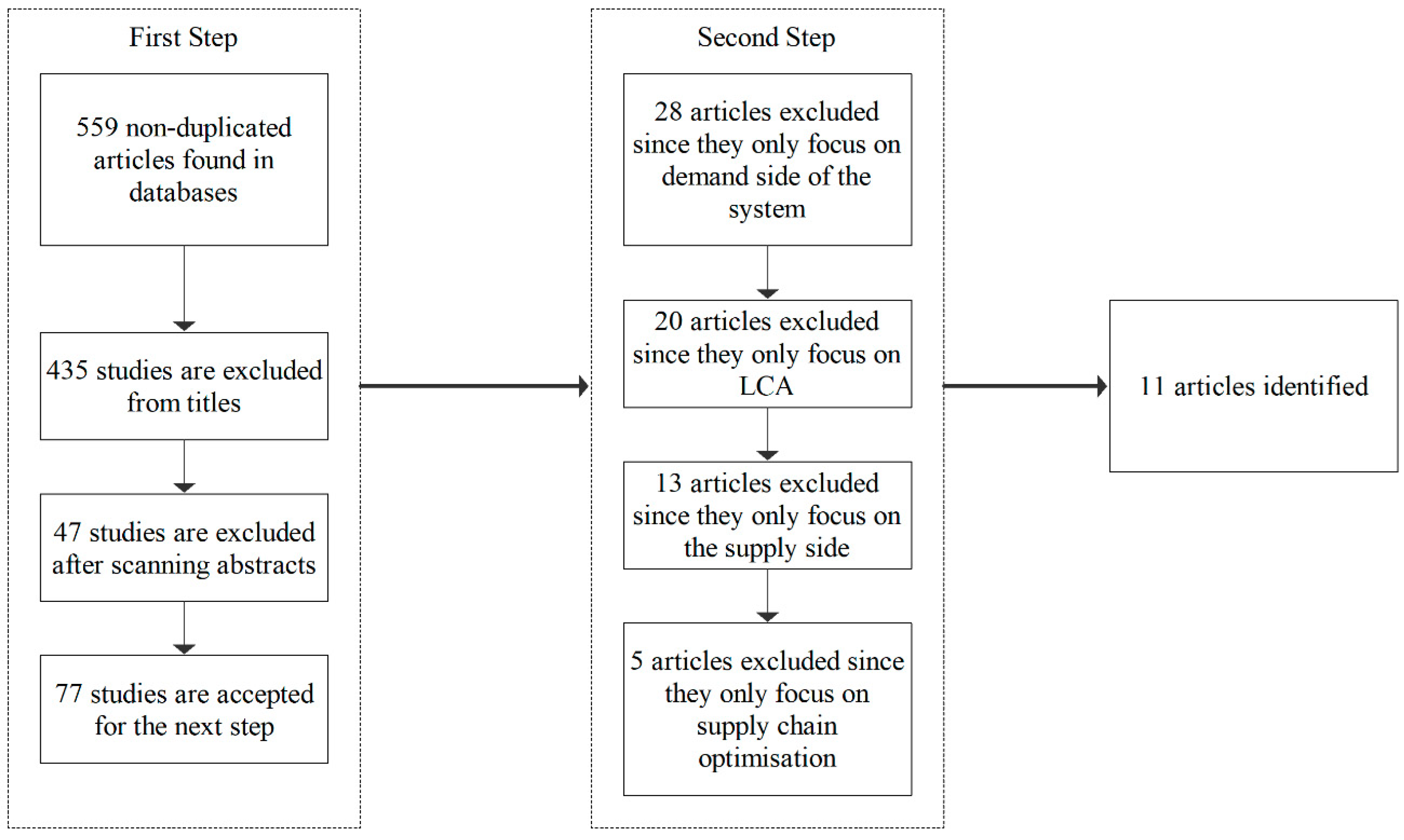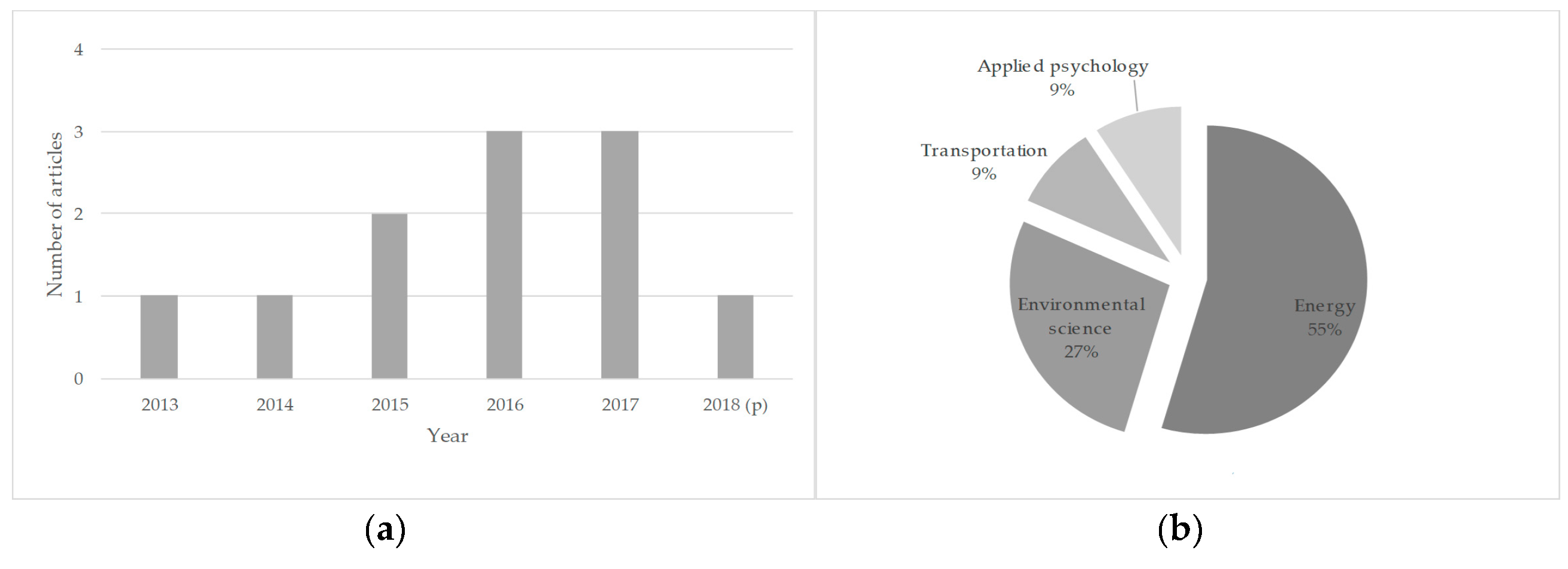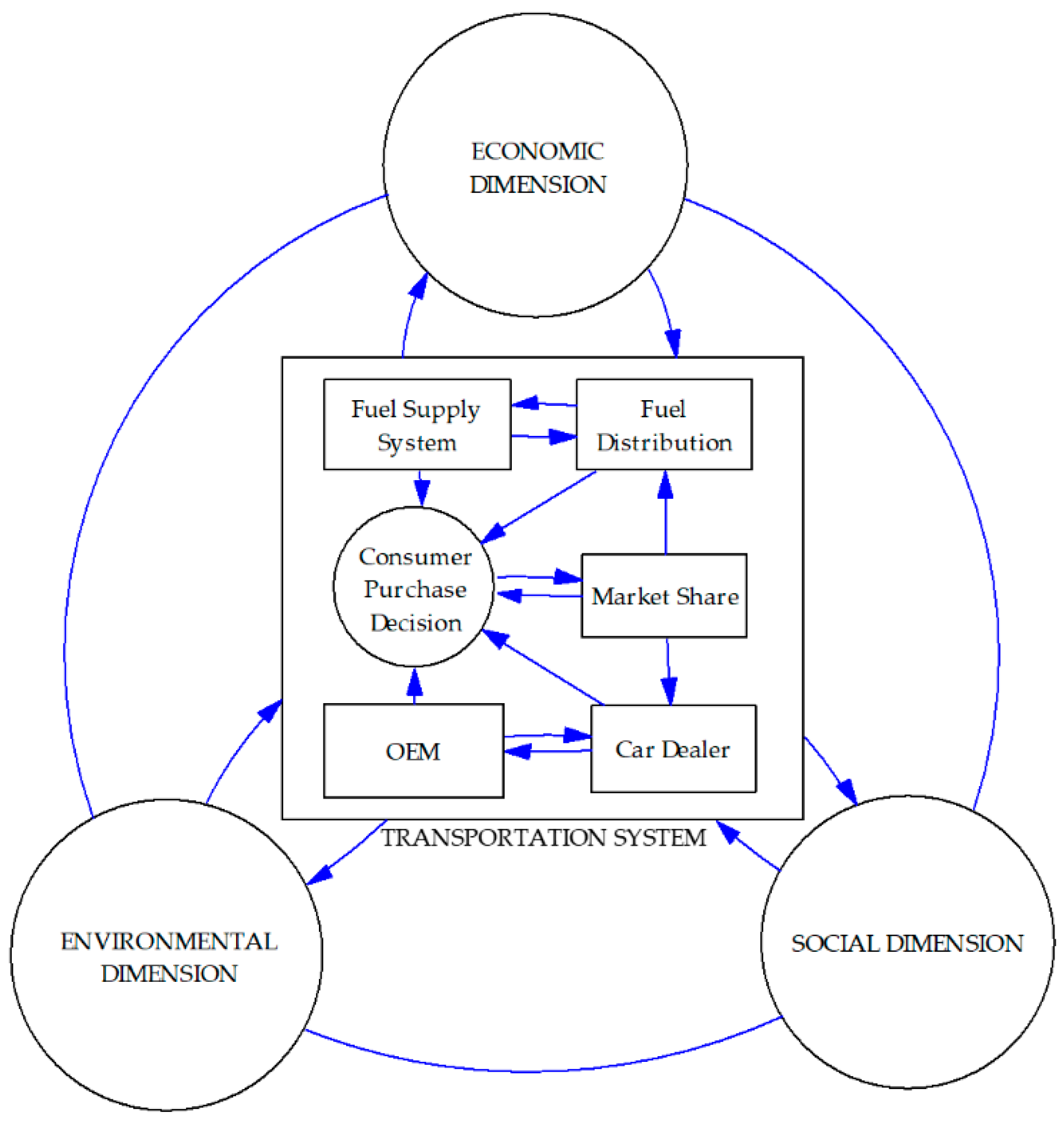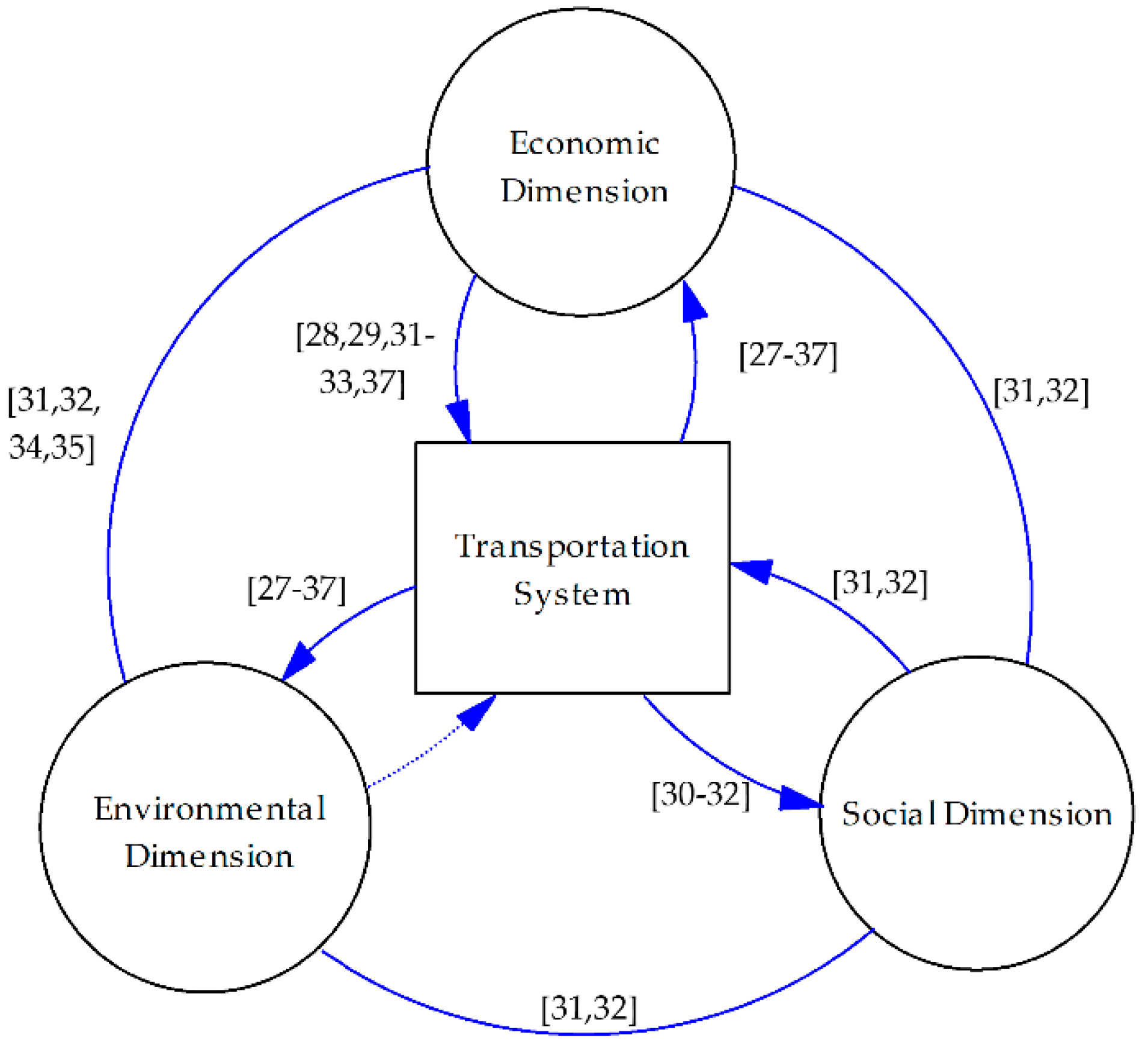This section is divided into five subsections. In the first subsection, we present the selected studies and the stakeholders and sustainability dimensions included in each one of the studies that were identified. In the second subsection, we present how the demand side of the system has been modelled in these studies; in the third, we analyse how the supply side of the system has been modelled; and in the fourth, we present how the dimensions of the sustainable development have been included and specify which performance indicators were used. Finally, we analyse how the integration of the demand, supply, and sustainability has been considered.
3.1. Selected Studies and General Results
The studies, year of publication, journal, and journal main subject area are presented in
Table 2. The studies selected using the methodology described above were primarily published in the journals Energy, Energy Policy, and Journal of Cleaner Production.
Including the sustainable performance index in the integrated modelling of the transportation system for the diffusion of EVs is a novel and increasingly popular research topic in the last five years, as can be observed in
Figure 2a. We can also observe, from
Figure 2b, that the studies were primarily published in energy-related journals.
In the previous section, we defined the inclusion criteria considered to select the articles.
Table 3 lists the stakeholders and aspects of sustainability included in each of the studies selected.
In the above table, we observed that all the studies have taken into consideration the market share and the economic and environmental indicators. Similarly, only three articles [
30,
31,
32] took into consideration the social dimension of sustainability of their models; however, these do not include the consumer purchase decision model.
In terms of the supply side, only one article [
27] has taken into consideration all the actors. Fuel producers and fuel distributor are found in eight articles each, and six articles [
27,
28,
29,
34,
35,
37] considered both. Vehicle manufacturers can be found in seven of the selected articles, car dealers are found in six, and four articles [
27,
30,
33,
36] have considered both.
3.2. Demand-Side Modelling
The demand side of the transportation system has two components: the consumer and the market. The first one corresponds to understanding and modelling the behaviour of the consumer and how the consumer makes decisions regarding the selection of vehicles from among different alternatives. The second is used to understand the market share evolution.
Several reviews have already been performed on the topics of modelling the demand, modelling the market share, and forecasting the demand for EVs and the consumer preferences towards vehicles attributes [
7,
8,
9,
38,
39]. These reviews can be classified into two groups. The first group corresponds to reviews of the methods and modelling techniques for consumer and EVs market share forecasting [
7,
39], and the second one is focused on consumer behaviours and preferences towards vehicle attributes that have been considered for modelling the consumer EVs adoption process [
8,
9,
38].
The EVs’ market share forecasting and consumer modelling can be classified into three approaches: bottom-up models, top-down models, and hybrid models [
39]. Bottom-up models represent the system by aggregating heterogeneous characteristics of individuals; top-down models represent the system while applying macroeconomic theory and econometric and optimisations techniques with aggregated economic variables; and hybrid models combine both the former approaches [
39,
40].
Bottom-up models represent the demand using a micro-perspective approach, and they have two characteristics [
7,
39]. The first characteristic is that the consumer is modelled as an individual, and the individual decision can be identified. The EVs market share is the aggregation of the individuals’ decisions and is used to determine the sales figures for each technology and, therefore, the vehicle market share. The second characteristic is that the consumer selects from a set of vehicles, the vehicle that best suits its needs and preferences [
7,
39]. The set of vehicles is different for each individual, and it is dynamically established according to word-of-mouth and feedback received in the individual social network [
41]. Agent-based model (ABM) and discrete choice model (DCM) are considered bottom-up models as they represent the consumer in a disaggregated manner [
7,
39].
In the ABM, the behaviour of the system is based on the aggregation of individual decisions [
7,
39]. Different types of agents are included in these studies, from among which we can observe the consumer, which represents the demand for vehicles; the vehicle manufacturing companies, which represent the supply of the vehicles; the agents of the energy system representing the supply of fuels; and the government that establishes policies for regulating how the other agents act in the system [
7]. This approach has two advantages. The first one states that the consumer can be characterised individually with their preferences, needs, and constraints. The second advantage is that social interactions and the effect of word-of-mouth can be modelled in detail [
7,
39].
In the DCM, the consumer purchase decision is modelled based on random utility theory, wherein each individual will choose an alternative from a set of choices that maximise the personal utility of the individuals [
7,
8,
39,
42]. The choice of a specific alternative is based on the preferences of the consumers, which are driven by the attributes of the vehicles and individual-related variables [
8]. Several attributes of the vehicles can be found in the literature, and they have been classified into four groups: financial, technical, infrastructure, and policy attributes [
8]. Likewise, several individual related variables are found in the literature, and they account for the heterogeneity of the consumers such as socioeconomic and demographic characteristics; factors from psychological theories; interpersonal influence; and mobility, residence, and car-related conditions [
8]. Psychological theories comprise the use of a different set of factors to explain consumer behaviour including social norms, constructs, attitudes, perceptions, drivers, and barriers [
8,
9,
38].
In top-down models, consumer behaviour and EVs market share forecast are modelled in an aggregated manner including the diffusion process as an important characteristic of these models. SD and general equilibrium models (CGE) are classified as top-down models [
39].
In SD models, the sales figures are usually calculated as a growth rate of the vehicle stock and the market share is estimated by embedding discrete choice models to reflect the technology choice. As the interactions of the individuals are not explicitly modelled, a diffusion model is often included to capture the interactions between the individuals on an aggregated level [
39].
CGE models are input–output models that optimise at the macroeconomic level and assume the existence of utility-maximising and representative individuals, a complete market without external factors, and complete information. These models use aggregated economic data and are mainly focused on the impact analysis of policies, technology change, and other external factors [
39].
Based on the different modelling approaches, the selected studies were classified considering three elements: the modelling technique, diffusion process, and individual-related variables. The results are presented in
Table 4.
Three studies did not consider the consumer component of the demand side [
30,
31,
32]. In these studies, we can find other approaches to forecast the EVs market share. Günther et al. [
30] proposed an optimisation model wherein the sales of each type of vehicle were decision variables, and Onat et al. [
31,
32] used external data from official forecasts to analyse the demand side.
As observed from the results, all the models that had taken into consideration the consumer purchase decision process use the discrete choice model (MNL and NMNL) as the main component. These models can be implemented in an agent-based simulation [
27,
34,
35,
36], an SD model [
29,
33,
37], or CGE with a Monte–Carlo simulation [
28].
The studies in which the consumer has been modelled using an ABM estimate the market share by aggregating the individual purchase decisions while following a bottom-up approach [
27,
34,
35,
36]. The studies that use SD estimate the market share by computing the growth of the vehicle stock and multiplying it by the aggregated behaviour of the consumer while following a top-down approach [
29,
33,
37]. The CGE model calculates the vehicle demand using macroeconomic data and by applying the aggregated behaviour of the consumer [
28]. Although the studies that used a top-down approach for forecasting the demand comprised the use of a discrete choice model for the consumer, this was not used at an individual level, and they are, thus, not classified as hybrid models.
All the models took into consideration the diffusion and interpersonal influence. Depending on the modelling approach, the diffusion process can be on an individual level or in an aggregated manner. When using the ABM, the interpersonal influence is an essential factor, and it is included in the individual level, and the vehicle diffusion process emerges from the aggregated behaviour of the individual [
27,
34,
35,
36]. In SD and CGE, the diffusion process is considered in an aggregated manner, and it is mainly represented using the Bass diffusion model [
28,
29,
37]. It can also be found that the diffusion process has been modelled while only considering the market share exposure without the interpersonal influence and word-of-mouth aspect [
33].
All the ABMs [
27,
34,
35,
36] took into consideration heterogeneity explicitly. These studies considered four characteristics to categorise the population and its heterogeneity, sociodemographic attributes, economic attributes, geographical attributes, and the personal attitude towards innovation. The majority of the studies use sociodemographic attributes as the main characteristic, followed by the income and geographical attributes. Only one study [
28] considered the attitude of the person towards innovation as an attribute for determining the heterogeneity of the population.
To account for the preferences of the consumer, we identify the attributes that have been evaluated in the selected studies. These attributes are presented in
Table 5 and are classified according to the groups proposed by Liao et al. [
8].
All the studies that modelled the consumer purchase decision process have taken into consideration the financial, technological, and infrastructure attributes. It can be observed that the financial and infrastructure attributes are the main attributes used to evaluate the consumer preference and purchase decision. From the technological attributes, it can be observed that driving range and environmental performance are mainly used, and only two studies [
27,
36] took into consideration both these attributes.
3.3. Fuel Supply System
Two actors are considered in the fuel supply system: fuel production and fuel distribution. Different types of fuels have been considered in the studies: petrol, diesel, electricity, ethanol (E85), biodiesel (B20), compressed natural gas (CNG), biogas, and hydrogen. All the reviewed studies take into consideration petrol and electricity. Diesel was considered in five studies [
27,
29,
33,
36,
37]; hydrogen in five studies [
27,
28,
29,
33,
37]; both ethanol and biodiesel in four studies [
27,
29,
33,
37]; and biogas was considered in three studies [
27,
29,
37]. Only one study [
33] took into consideration CNG. Four studies [
27,
29,
33,
37] took into consideration seven of eight types of fuels, while CNG or biogas was not considered in their research scope.
Several approaches were used to model the actors of the fuel supply system. SD [
27,
29,
31,
32,
37] and LCC [
34,
35] were used to model the producer. Using an LCC approach, the production flow, production cost, and emissions are calculated using the aggregation of the different components and resources used to produce each type of fuel. The SD approach allows for the computation of the cost of the fuels and production flows subject to resource limitations and the learning rate.
The SD, ABM, and CGE models were used to model the fuel distribution actor. The fuel distribution is mainly represented as the infrastructure associated with the distribution of each type of fuel to the consumer, such as service stations and charging stations. In an SD approach, the number of stations is represented as a level and the decision over this variable is subject to the expected demand for fuel, quantity of fuel available, and economic constraints. In an ABM approach, other types of constraints are also used, such as location and how this location can affect the diffusion process of EVs, as one of the main barriers for the diffusion process of EVs is the lack of charging stations and the visibility of these in cities and on roads [
43,
44]. Greene et al. [
28] use a CGE model for the fuel distribution, while focusing on infrastructure deployment and investment for hydrogen fuel stations.
Five studies [
27,
29,
34,
35,
37] comprised the modelling of both actors of the fuel supply system. Three of them [
27,
29,
37] uses SD for both actors. The other two [
34,
35] comprised a combination of LCC and ABM. Using SD to represent both actors facilitates the integration of the production flow and distribution flow, and the costs perceived by the consumer can be explicitly determined and analysed. Using LCC and ABM facilitates the analysis of the regional effect that the location of the fuel station can have over the fuel cost. One study [
30] did not take into consideration the fuel supply system as an actor in their model as the scope of their optimisation problem was the automotive supply chain.
Table 6 presents the approaches adopted to model each actor of the fuel supply system and the fuels considered.
Several variables are used to model the fuel supply system. All the studies that had considered this system comprised the use of the fuel cost as the primary variable. The fuel availability was considered as the number of stations for each type of fuel available in the system and is the second most used variable. Only two studies [
31,
32] did not take into consideration the fuel availability as a variable as they did not consider the fuel distribution actor in their models. Only three studies [
27,
29,
37] included all the variables considered in this review in their models. The relationships of these variables with the other components are reviewed in an integrated manner in
Section 3.6.
Table 7 presents the variables that had been used to model the fuel supply system and which articles had taken them into consideration. We only list the studies that had taken into consideration the fuel supply system in their models.
3.4. Vehicle Supply System
The vehicle supply system can be grouped into two main actors: the original equipment manufacturers (OEMs) and the car dealer. OEMs make decisions regarding the number of vehicles produced and the vehicle attributes for maximising their profit [
13,
27,
45,
46,
47,
48]. Car dealers seek to maximise their profit by offering various vehicle types. They order vehicles from local and international OEMs according to the expected demand for each type of vehicle [
27]. They also advertise new vehicles to maximise the expected sales [
33].
Different powertrains have been considered in the studies: internal combustion engine (ICE), hybrid electric vehicle (HEV), plug-in hybrid electric vehicle (PHEV), battery electric vehicle (BEV), and fuel cell vehicles (FCV). All the studies took into consideration the ICE and electric engine (P/H/EV). Only five studies [
27,
28,
29,
33,
37] considered fuel cell vehicles in their models.
Several approaches have been found for modelling the OEM. We can use SD models, CGE models, optimisation models, and LCC models. In the LCC model [
34,
35], the retail price of a vehicle is calculated by aggregating the price of each component of the vehicle toward the life cycle of the product. Greene et al. [
28] used a CGE approach to model the vehicle supply system. In this approach, the price of the vehicles is calculated using learning curves and the number of vehicles sold. Günther et al. [
30] considered these actors as echelons in the sustainable supply-chain network optimisation problem.
Three studies [
27,
33,
36] used SD to model the OEM; these studies also considered the car dealer actor, and they modelled both actors in an integrated manner. This approach allows for the constant exchange of production flow and information between the OEM and the car dealer actors, using the stock of the vehicle on the car dealer agent as a linking component.
To model the car dealers, we can use the SD and optimisation models, as SD is the most used approach. Five articles [
27,
31,
32,
33,
36] comprise the use of SD for modelling the car dealers. This approach allows the integration flow of vehicles and information from the dealer to the demand and forms the demand for the dealer, while using the sales flow and demand as linking variables between the actors.
Table 8 presents the approaches used to model each actor of the vehicle supply system and the powertrains considered.
Several variables have been used to model the vehicle supply system. Sales flows and retail price are the two main variables used in the studies. Another important variable is research and development and its relationship with the production cost and technical attributes of the vehicles. This relationship is important as the consumers evaluate these attributes (cost and technical attributes) according to their preference for selecting one type of vehicle [
27,
28,
33,
36]. Other variables used in the studies are the number of vehicles produced by the OEM, the expected demand for vehicles, and the distribution cost [
27,
30,
33]. Only Shafiei et al. [
27] considered all the variables analysed in this review. The relationships and interactions of these variables in the transportation system and the dimension of the sustainability are analysed in an integrated manner in
Section 3.6.
Table 9 presents the variables used to model the vehicle supply system and which articles had considered them.
3.5. Sustainability Assessment
In this section, we present the key performance indicators used in the studies, grouped by the dimension of the sustainability to which they are associated. All the studies comprised the use of economic and environmental indicators, while only three studies [
30,
31,
32] comprised the use of social indicators.
In terms of the economic dimension, we found that the market share composition is the most used key performance indicator in nine of eleven studies, followed by fuel consumption and total cost, both in six of eleven studies. The other two indicators, the gross domestic product (GDP) and government revenue and the environmental damage cost are only used in three [
31,
32,
37] and two studies [
34,
35], respectively.
The market share indicator is related to the evolution of each vehicle over time, which is the key objective of the diffusion process. The fuel consumption represents the quantity of energy used in the case of each type of technology, and it is associated with the energy security of the region in which the study is focused. The variables of GDP and government revenue are linked together and represent the macroeconomic growth of the region of study. The environmental damage cost is related to the cost associated with climate change and air pollution and affects the macroeconomic equilibrium of the system.
Table 10 presents the indicators considered by the selected studies. In this table, it can be observed that none of the studies took into consideration all the indicators, while the maximum number of economic indicators used is three, and only six studies [
31,
32,
33,
34,
35,
37] had considered this number of indicators. The other five studies [
27,
28,
29,
30,
36] considered two indicators.
In terms of the environmental dimension, the emission of greenhouse gases (GHG) in the operation phase of the vehicles is the primary environmental indicator. Only the study of Kieckhäfer et al. [
36] lacked an explicit evaluation of the GHG emission in the operation phase. They estimated the energy use and fuel consumption and inferred that a reduction in GHG emissions was caused by the energy use; however, they did not estimate the value of this reduction. Along with the GHG emissions in the operation phase, the estimation of energy use is the second most-used variable in the studies.
We can see from
Table 10 that the studies that analysed the fuel consumption as an economic indicator also analysed the energy use due to the direct relationship between them. We considered these two indicators independently as the fuel consumption is related to the energy security, which is a macroeconomic indicator, and the energy use is related to the energy efficiency of the vehicles, which is an environmental indicator.
The GHG emissions in the production phase for both vehicles and fuel production was studied in four articles [
31,
32,
33]. Günther et al. [
30] in their optimisation problem only considered the GHG emissions for the production of the vehicle. All these studies comprise an estimation of the carbon footprint of the supply chains and the operation of vehicles using a life cycle perspective.
Other environmental impacts were assessed in the selected studies. We found that the impact of the operation of vehicles on urban air quality was estimated using the emissions of volatile organic carbon, particulate matter, and nitrous oxide [
28,
31,
32]. Onat et al. [
31,
32] also considered the effect of these indicators in the production phase and evaluated the effect on the air quality using a life cycle perspective.
Lastly, we found that the water footprint of the fuel supply chain was considered in two studies [
34,
35]. They evaluated the water consumption and water withdrawal in the production phase of the fuels.
Table 11 lists the articles that included the aforementioned indicators. None of the selected articles took into consideration all the indicators, and only two studies [
31,
32] considered the majority of the indicators by using a life cycle perspective, while analysing both the production and operation phases and the GHG and air pollutants.
In terms of the social dimension, only three studies [
30,
31,
32] considered indicators from this dimension in their models. Günther et al. [
30] analysed employment as part of the objective function in the optimisation problem. They sought to minimise this indicator, which is calculated as the sum of dismissals and jobs created in each production process of the supply chain over all the locations and periods of time.
Onat et al. [
31,
32] also considered employment as an indicator of the system. This indicator depends on the economic performance of the system. They also considered two additional social indicators: human health and public welfare. To evaluate human health, they adjusted the life expectancy due to mortality and morbidity caused by climate change and air pollutants. In the case of public welfare, they considered the human development index (HDI), which is the geometric average of the income, education, and life expectancy indexes. The relationships of these indicators and the system are analysed in
Section 3.6.2.









